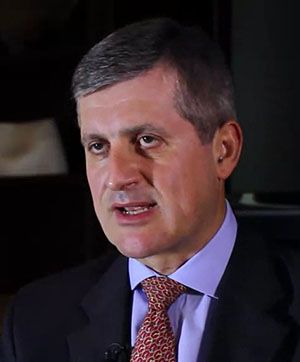A Marathon, Not a Sprint: Spiro Rombotis, CEO, Cyclacel
Cyclacel (Berkeley Heights, NJ) is a clinical-stage biopharmaceutical company developing innovative cancer medicines based on cell cycle, transcriptional regulation, and mitosis biology. Its aim is to build a diversified biopharma business based on a pipeline of novel drug candidates that address oncology and hematology indications.
President and CEO Spiro Rombotis joined the company as its first CEO in 1997. Rombotis began his career in the early 1980s, after training at Novartis, as one of the first employees of Centocor (subsequently acquired by Johnson & Johnson). His industry experience has seen him participate in the in-licensing, clinical development, regulatory approval, partnering and commercial launch of several drugs, mainly in inflammation and hematology/oncology, including Abelcet, Evacet/Myocet, and Remicade.
Pharm Exec caught up with Mr. Rombotis recently to talk about the changes he has seen during his 36 years in pharma and biotech and how he remains excited and motivated by Cyclacel’s current work on solid tumors and lymphomas.
You’ve had a long and successful tenure as CEO of Cyclacel Pharmaceuticals. Can you outline what have been the highlights/your proudest moments during that time?
Spiro Rombotis

The most important highlight was the privilege of working with a team of inspiring people who are dedicated to helping cancer patients in need. Despite the high chance of failure in cancer research, we have persisted on the idea that harnessing the cell cycle could be valuable in several types of cancer. Seeing that idea become a reality from us and other companies is incredibly fulfilling. Learning that our drugs stopped an aggressive cancer or induced partial or complete responses in “incurable” patients remains an enduring source of pride that propels us forward. These are real people with families and loved ones we are helping reach improved quality of life and a better chance of survival.
What would you say are the most significant ways in which the industry has changed since you started at Cyclacel?
The shift from defining cancer in terms of the anatomy of affected organs to a disease treated according to its genetic profile is without doubt the most significant change in my 36 years in the industry. Today’s precision medicines will become even more effective in the near future. The original breakthroughs in structure-based drug design will be coupled with advanced data analytics, AI and fast biopsy technologies to help define target patient groups by genomic or proteomic profile. New strategies to degrade proteins that confer an advantage to cancer will emerge alongside immunology and cell therapy technologies to push out the survival envelope in many cancers. The globalization of the biotech industry and the emergence of innovation from around the world will probably accelerate in the post-pandemic era. Capital is fungible and the early successes with coronavirus vaccines and treatments will result in increased investment flows into our industry.
What is distinctive about the company culture at Cyclacel?
Our culture is defined by the values we hold dear: scientific intensity, integrity, camaraderie and respect for each other, our stockholders, collaborators, competitors, patients, physicians, and society. I am particularly proud of our team’s sense of resilience and ability to learn from our failures and those of others. We are also a multicultural company with UK and US operations and global clinical trials. On a lighter note, we have been accustomed to remote working and video conferencing across time zones for many years before it became a global necessity.
How do you remain motivated as a leader in this industry? Are you still driven by your early experience working at a hospice?
Our industry is for marathon runners not sprinters. The chance of entrepreneurial success is remote and can only be achieved with dogged persistence. Two formative experiences defined what was to follow. While I was a graduate student, I received practical experience at a hospice where many of the patients were children with poor survival. It felt debilitating to just watch as they came and went. I decided to work in the biopharma industry and in the mid-80s was fortunate to join Centocor, a small biotech pioneer who brought monoclonal antibodies to the bedside, a breakthrough technology which today is a multi-billion-dollar industry. Those first years at Centocor were hard, and failure or running out of cash was never far away. Motivation correlates with experience, and I have been blessed to have plenty of both.
What is exciting about the current work on solid tumors and lymphomas that Cyclacel is engaged in?
I can’t wait to get to work in the mornings as we are now entering one of the most exciting periods of the company’s history. The drug classes we are working on are receiving a lot of attention from physicians and companies. We have recently begun two midst age clinical trials in patients with solid tumors or lymphomas and separately in leukemias with our lead drug. Early next year we will open another two studies with our second drug candidate. This is the culmination of many years of work on the laboratory bench and early-stage trials. Together these four trials could generate as many as 25 different outcomes in the near future. Because they are designed to enable registration discussions, any one of these 25 “shots-on-goal” may lead to regulatory approval.
What is your vision for the company for the next few years?
It is simply to deliver on the promise of our drug candidates for the benefit of patients. Executing on our ambitious clinical programs, defining safe and effective dosing schedules, identifying patients who may achieve clinical benefit and plotting a course for regulatory approval and launch is a busy agenda. We are number 1 or number 2 in the respective drug classes and we have a duty to move swiftly. It is gratifying to see that clinical investigators have high interest in our programs and we look forward to disclosing new preclinical and clinical results over the next few years.